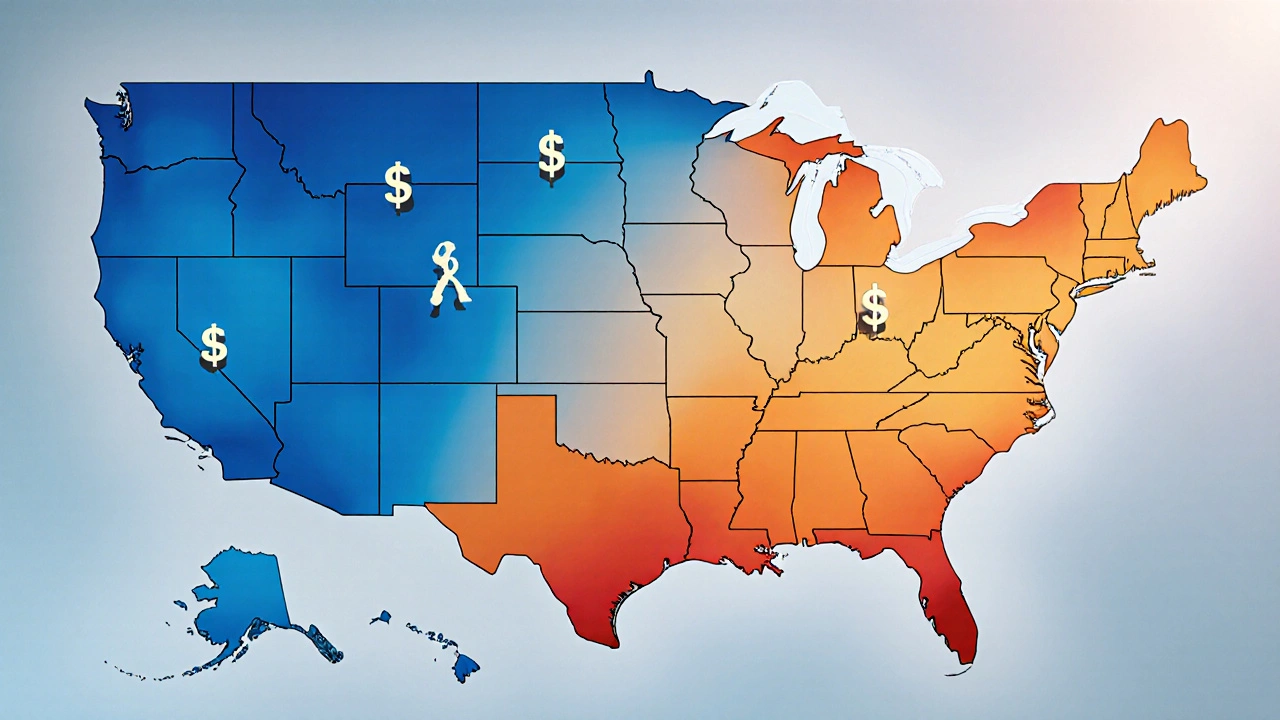IVF Cost Estimator by State
Compare IVF Costs by State
When you’re planning a family, the price tag on in‑vitro fertilization (IVF) can feel like a wall. But the wall isn’t the same everywhere - some states charge far less per cycle than others. Below you’ll find a clear picture of where the U.S. offers the most wallet‑friendly IVF, why those price gaps exist, and what to weigh besides the sticker price.
What "IVF" really means and why costs vary
IVF is a reproductive technology that combines an egg and sperm outside the body, then transfers the resulting embryo back into the uterus. It’s a multi‑step process that may include ovarian stimulation, monitoring, egg retrieval, fertilisation, embryo culture, and transfer. Each step brings its own fees - medication, lab work, physician time, and facility use - which explains why the final bill can swing dramatically from one location to another.
How we measured state‑level IVF costs
Our cost analysis pulls from three reliable sources:
- The Society for Assisted Reproductive Technology (SART) 2024 national data set, which reports average charges per fresh IVF cycle.
- State health‑department surveys that track insurance mandates and public coverage levels.
- Patient‑reported expenses on the FertilityIQ platform, giving a real‑world view of out‑of‑pocket spend.
All figures are adjusted to 2025 dollars, rounded to the nearest $100, and reflect a typical first‑attempt cycle without add‑ons like pre‑implantation genetic testing (PGT).
Top five states with the cheapest IVF cycles (2025)
| State | Average cost per cycle | Typical insurance coverage* | Live‑birth success rate (per cycle) |
|---|---|---|---|
| Mississippi | $9,500 | 10‑15% | 32% |
| Arkansas | $10,000 | 12‑18% | 34% |
| Alabama | $10,500 | 15‑20% | 33% |
| West Virginia | $11,000 | 13‑17% | 31% |
| Kentucky | $11,200 | 10‑14% | 30% |
*Coverage percentages represent the portion of the total bill that state‑mandated insurance plans typically reimburse for patients who meet eligibility criteria.
These states share three common traits: lower clinic overhead, a higher concentration of university‑affiliated fertility centres that receive research grants, and, in many cases, less stringent state licensing fees for reproductive labs.

Why some states are pricier
Contrast the cheap states with the most expensive pockets, like California ($15,000), New York ($14,500), and Massachusetts ($14,000). The price gap often stems from:
- Higher labor costs. West Coast and Northeast metros pay clinicians and embryologists more, which trickles down.
- Advanced technology adoption. Clinics that invest early in time‑lapse imaging, next‑generation sequencing for PGT, or AI‑driven embryo selection charge a premium.
- Insurance mandates. States with robust IVF coverage (e.g., Massachusetts) see higher average charges because insurers reimburse a larger slice, encouraging clinics to bill at full price.
- Regulatory environment. Some states require extra lab certifications or impose caps on maximum embryo transfers, increasing administrative work.
Key players that affect cost
Understanding the ecosystem helps you spot ways to trim expenses.
- IVF clinic: Large university hospitals often offer lower per‑cycle fees than private boutique centres because they spread costs over many patients and receive research funding.
- Insurance provider: Some carriers include IVF as an optional rider; others only cover it if a state mandate applies. Checking your policy’s fine print can shave several thousand dollars.
- Fertility specialist: Experienced reproductive endocrinologists may charge higher consultation fees, but they also tend to have higher success rates, which could reduce the total number of cycles needed.
- Success rate: A clinic’s live‑birth rate per cycle is a critical efficiency metric. Higher success can mean lower overall cost, even if the per‑cycle price is modestly higher.
- Medical tourism: Patients sometimes travel across state lines (or even abroad) to combine lower fees with reputable care. 2024 data shows a 12% rise in U.S. patients seeking IVF in Mexico and the Czech Republic for cost savings.
How to reduce your IVF bill without compromising care
- Shop around within your state. Even in pricey regions, some clinics publish transparent, itemised price lists. Request a detailed quote that separates medication, lab work, and physician fees.
- Ask about shared‑risk or refund‑guarantee programs. A few clinics now offer a flat fee that includes a second cycle if the first fails, which can average out to a lower cost per live birth.
- Leverage insurance. If you live in a state with IVF mandates (e.g., Illinois, New Jersey), submit your claim promptly and keep all receipts for potential out‑of‑network reimbursement.
- Consider medication savings. Some patients use generic gonadotropins or join bulk‑purchase programs. Discuss these options with your fertility specialist.
- Plan for travel. If a neighbouring state offers a $2,000‑$3,000 discount, factor in travel, lodging, and lost‑wage costs. Often the net saving still outweighs the extra expenses.

Beyond price: what else matters
Cheapest isn’t always best. When you compare clinics, add these criteria to your decision matrix:
- Live‑birth success rate. Look for rates specific to your age group; a clinic with a 38% success rate for women under 35 may be a better value than one charging $2,000 less but delivering 28%.
- Embryo handling policies. Some centres limit the number of embryos you can freeze, which could affect future costs if you need another attempt later.
- Patient support services. Counseling, nutrition advice, and flexible scheduling can reduce stress and improve outcomes.
- Legal environment. States differ on embryo ownership, donor anonymity, and surrogacy rules. Ensure the legal framework aligns with your family‑building plan.
Quick reference checklist for cost‑conscious IVF planning
- Identify your state’s average IVF cost (e.g., Mississippi ≈ $9,500).
- Check if your insurer covers any portion of IVF in your state.
- List the top 3 clinics in your area with the best live‑birth rates.
- Contact each clinic for a line‑item quote and ask about discount programs.
- Calculate total out‑of‑pocket cost after insurance reimbursements.
- Factor in travel, accommodation, and lost‑wage expenses if you consider an out‑of‑state clinic.
- Compare overall value: cost vs. success rate vs. patient experience.
Frequently Asked Questions
How is the price of an IVF cycle calculated?
A typical IVF bill combines medication (often $3,000‑$5,000), monitoring (ultrasound and blood tests around $800), lab work (egg retrieval, fertilisation, embryo culture $4,000‑$6,000), physician fees, and facility charges. Clinics may bundle these items or list them separately; the latter gives you more room to negotiate individual components.
Does any state fully cover IVF through insurance?
No state offers 100% coverage for all patients, but several (e.g., Massachusetts, New Jersey, Rhode Island) have mandates that require insurers to cover at least one IVF cycle for eligible couples. Coverage limits, age caps, and diagnostic prerequisites vary, so review your plan’s fine print before assuming full reimbursement.
Why are IVF costs lower in the Southern states?
Lower living costs, fewer regulatory fees, and a higher proportion of academic medical centres that receive grant support keep overhead down. These factors translate into lower charges for patients, especially when the clinic offers volume discounts for multiple cycles.
Is it worth traveling to a cheaper state for IVF?
Travel can make sense if the cost difference exceeds $3,000‑$5,000 after accounting for airfare, lodging, meals, and time off work. Also weigh the clinic’s success rates and your comfort with being away from home during the critical stimulation phase.
Do cheaper clinics have lower success rates?
Not necessarily. Many low‑cost clinics are university‑affiliated research centres with success rates comparable to high‑price private practices. Always compare live‑birth rates for your age group, not just price tags.
Knowing which state offers the cheapest IVF states gives you a starting point, but the smartest choice balances price, success, and personal comfort. Use the checklist above, ask the right questions, and you’ll be better equipped to turn the dream of parenthood into reality without breaking the bank.





